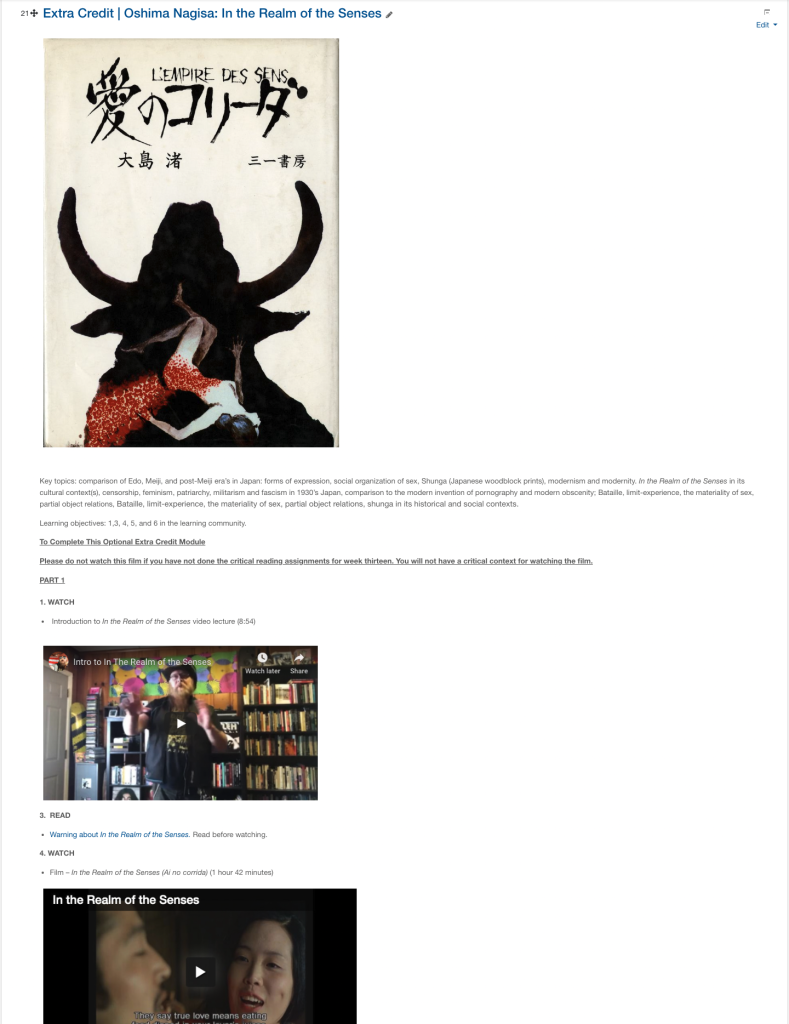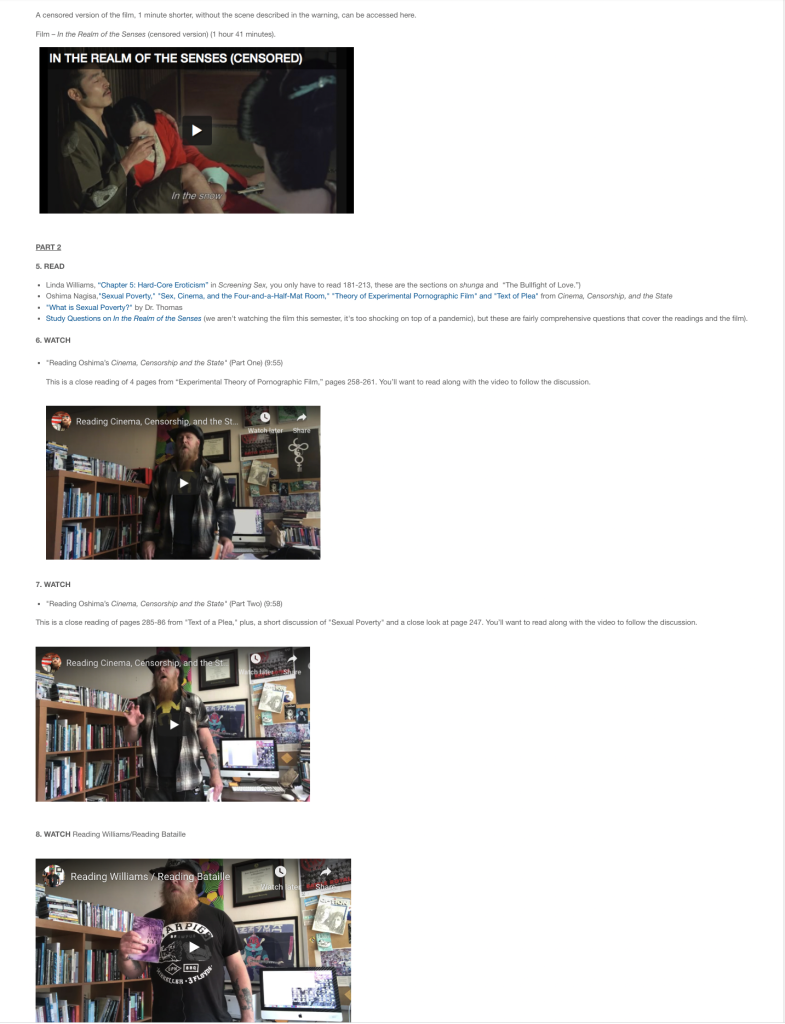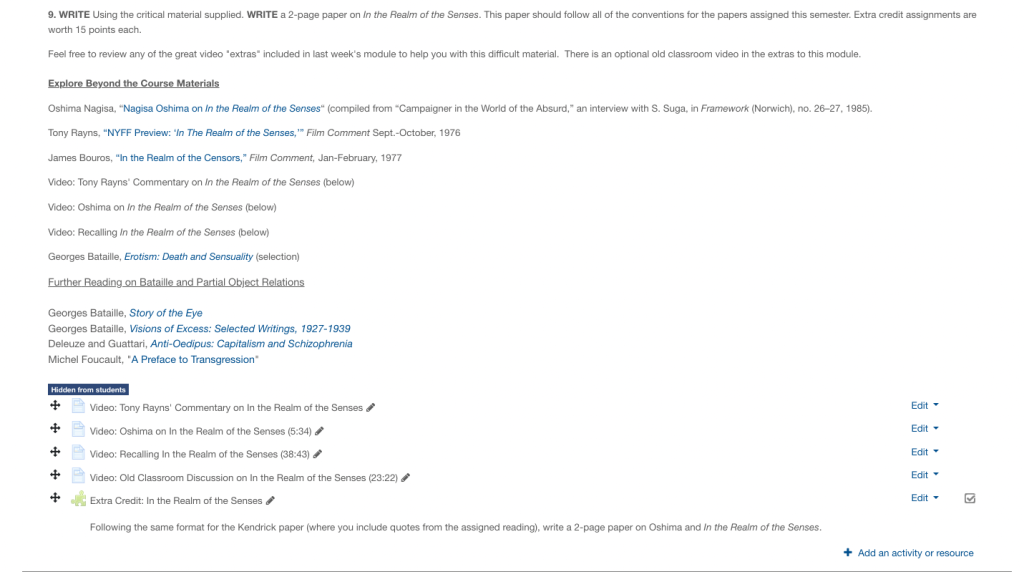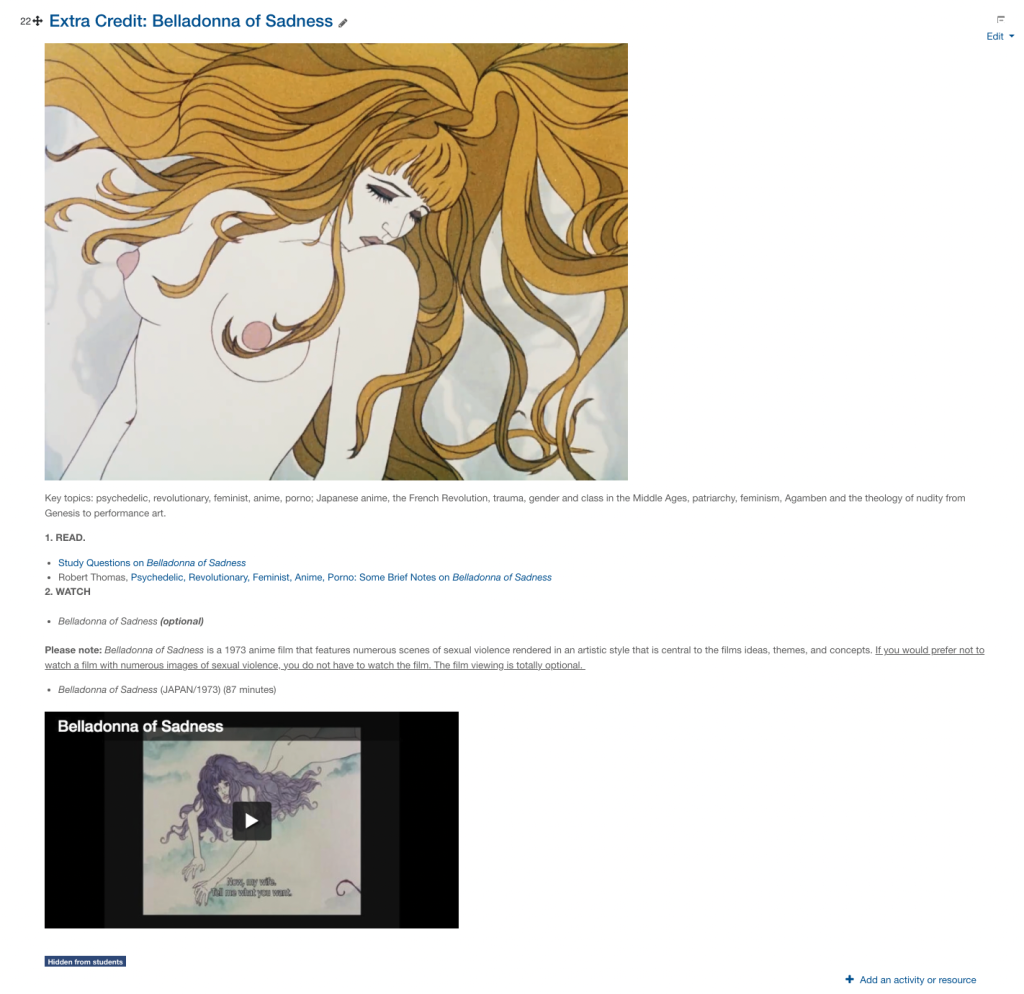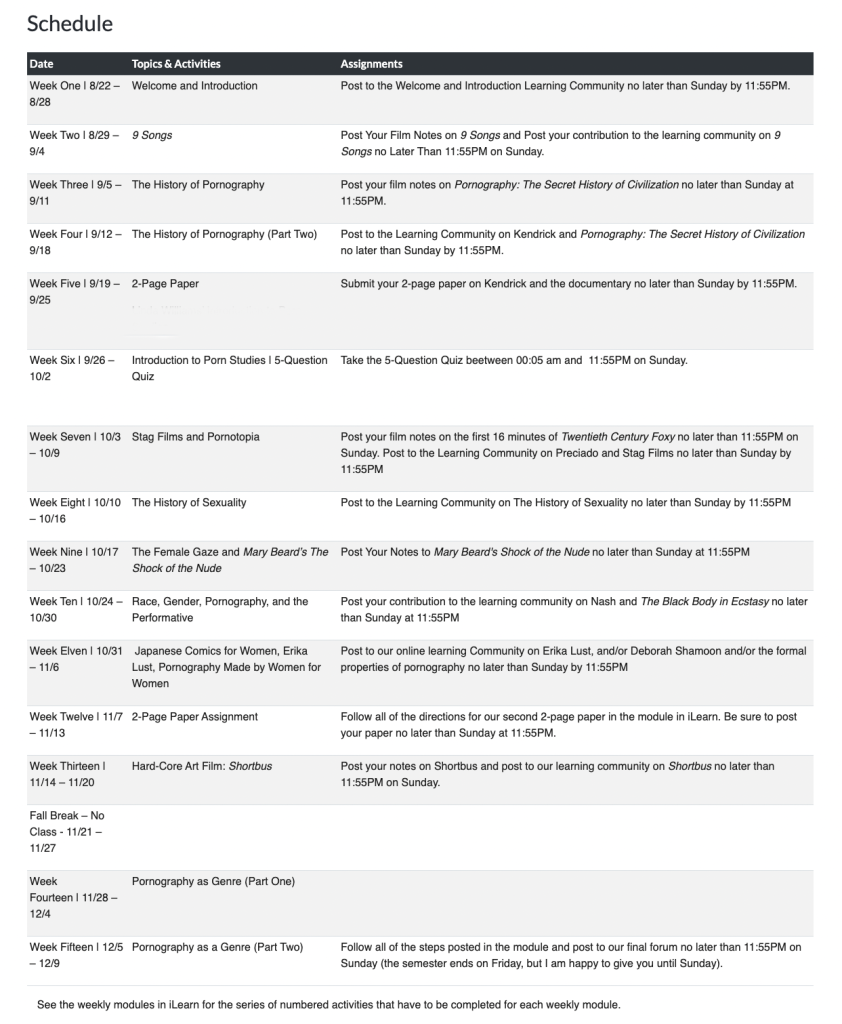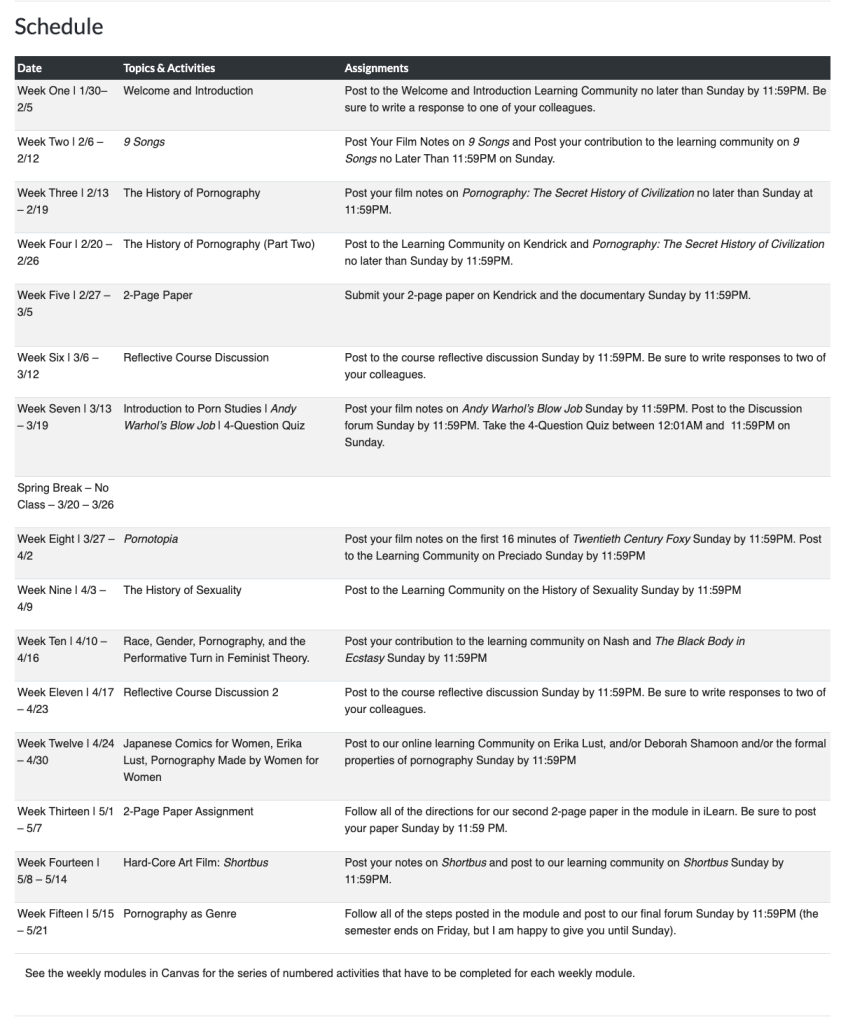Revisions to HUM 390
This is a design document of the revisions to the syllabus, instructional videos, presentation, language, assigned readings and grading structure for HUM 390, Images of Eroticism, as part of the transition to Canvas for spring 2023. It is part of the larger process of course assessment and design.
Revision Document
This is my course revision (or, iterative design) document. It lists the work I have done as part of the transition from iLearn to Canvas, including the assessment and iterative design process as part of that transition. Items crossed off this list indicate work that has been completed as of 1/17/23. The few things I have left to do are not yet crossed off.
- All Instructional Media Moved from iLearn or YouTube to Vimeo (so it can be embedded on the page for a better student experience, not have ads via YouTube, and not be links to iLearn).
- Build and setup Home Page in Canvas
- Build Out All Course Modules in Canvas with all media (video/PDF’s) included in the build.
- Make sure all directed activities are included in the modules
- Make sure all time-locks are included in modules
- Iteration and review of grading structure changes: minimum 30 points for Kendrick paper 20 points for Bijou Paper assignments (50 percent of the grade), reduction of credit for forum posts (3), reduction of credit for film notes (2). Evaluation of final distribution of grades. Modify exam.
- Attend 1 hour student presentation on transition to Canvas
- Put Key Topics in headers for weekly modules
- Write directed activity for Williams’ porn studies discussion
- Make sure all grading for assignments and papers are set up properly in Canvas (minus quiz).
- Make sure list of Assignments are in the proper order
- Learn how to make a quiz in Canvas
- Update and reuse old Learning Community Guidelines for the course
- Be sure to add all (Optional) next week’s reading assignments for the students
- Move two chapters from The Black Body in Ecstasy to (Optional) readings (i.e. break up the PDF chapters in Acrobat, including the books notes, for the students).
- Download then Upload Nash’s lecture video to Vimeo so it can be embedded for the students in the page (and not used as a link) for a better student experience.
- Revise and upload study questions for the Nash module.
- Revise “introducing race, gender, and pornography” video.
- Review all instructional videos for the Nash module to make sure they conform with the new arrangement of assigned materials.
- Revise introductory video for Nash module to conform to second iteration of material.
- Edit 20th Century Foxy down to the assigned 16 minutes to cut down on bandwidth usage and to be more student centered (so they don’t spend time or be intimidated by the length of the full documentary, all of which is not assigned).
- Build and revise syllabus in syllabus tool based on iterations in the course assignments and grading structure and use of Canvas.
- Edit/Revise Welcome video
- Edit/Revise Introduction video
- Add name/credit to the infographic timeline I made on the history of the concept of pornography
- Buy, digitize and upload new version of Shortbus with factory made captions
- Add two extra credit modules
- Build out and Iterate extra credit modules (e.g. modify assignment directions, add weekly emails from regular class session, change link of Senses of Cinema to a PDF-eliminating ads/distraction as well as providing a secure link to the article, moving all extra credit content from iLearn to Canvas and modifying the prompts)
- Learn about announcements time coding for Canvas
- Code and input all Announcement messages.
- Cut back the Nash reading (Past page 8) in the “Introduction” to make it easier for students
- Modify instructional video on Nash based on these changes
- Modify study questions on Nash based on these changes
- Modify study questions on 9 Songs
- Modify module on 9 Songs to include video extras (from me, the director and the actors)
- Add Linda Williams’ 5-pages from “Philosophy in the Bedroom,” titled “Lyrical Sex” to 9 Songs module
- Remove “From 9 Songs to the Secret Museum” video due to these revisions
- Add my own subtitles to 9 Songs that include the song lyrics in the subtitles
- Add film notes assignment to the Warhol short film
- Write short video script kindly discussing the errors in Williams’ 9 Songs piece, “Lyrical Sex”
- Revise SFSU Syllabus and Output PDF based on date changes
- Write “How to Use Canvas” for this class script.
- Eliminate Mary Beard module. Unpublish the Mary Beard module and eliminate the assignment for that work.
- Cut down week 14/15. Merge the work into one week instead of two.
- Add course reflection forum for week six (covering weeks 1-5) and a second reflective forum at week eleven (covering weeks eight to ten). This gives students a sense of agency as well as consistency about the work we’ve covered, forcing them to verbalize connections between the work we’ve done, thereby making the post-pandemic version of the course more consistent.
- Change the grading structure for the Quiz from 5 to 4 points to accommodate the above changes.
- Adjust the schedule and Grading and Assignments in the Syllabus.
- Attend one hour webinar on Canvas communications presented by CEETL.
- Modify the Announcements based on the latest iterations.
- Write new announcements for the Reflective discussion posts for weeks six and eleven.
- Combine the (now) separate “Welcome” and “Introduction” video scripts into one script, removing any repetition of content.
- Edit Introducing 9 Songs video (remove section that is no longer relevant due to iterative changes)
- Check for any Viemo videos that are 1080p and reupload in 720p to cutdown on bandwidth usage.
- Attend one on one meeting with ID about the Canvas transition.
- Make “How to Use Canvas” for this class screencast video.
- Make Grading and Assignments screencast video.
- Shoot new “Welcome and Introduction” video based on the new script.
- Adjust and correct captions for the first week videos
- Edit/revise first week Welcome announcement acknowledging Canvas transition
- Create new versions of Announcements for HUM 390-02 section
- Make short video on thinking about Williams’ reading of the film 9 Songs based on her ‘Lyric Sex.
- Move the “explore more” content (which was in iLearn at the end of each module) to a single Page in its own module located at the very end of the semester modules (below the extra credit). Transfer all of this content from iLearn to Canvas (so it’s no longer presented in a way that is overwhelming to students in the weekly modules but is still available to them). —do this after the semester has started
1.0. Initial Thoughts on Spring 2023 Revisions
I am happy with the majority of these student-centered changes (this was a lot of work). I am concerned about the addition of a reflective forum in the fifth week because it is due the same day as their first paper. I would prefer to break this up and give students a whole week to do the reflective forum post (after they have turned in the paper). This would mean eliminating a week of other work (e.g. Mary Beard’s Shock of the Nude, which was added as a post-pandemic form of “breathing room” for students).
The Permanent Loss of Pre-Pandemic Content
A lot of foundational content for this course had to be removed due to the pandemic.
For nearly two decades, I taught two full weeks on the work of Japanese theorist and filmmaker, Oshima Nagisa. iLearn is punishing. It doesn’t save older versions of your courses (which can be gone before you know it). Below is an image of what this two weeks of course modules looked like (compressed into a 2-part extra credit module) in the fall of 2020. There was a directed activity for the forum post during the regular AY and a paper prompt, as well as two weekly announcements for this content. Writing about this work was required for the final paper and to demonstrate proficiency in the course material across the arc of the course, from beginning to end.
I eliminated final papers and exams in this course due to the pandemic. I am keeping this structure in most of my courses because I’ve found that I can do quality assessments of student learning with directed activities, including a culminating work assignment. I have also accepted the fact that I can no longer teach Oshima Nagisa’s work.
Graphic: Addition of two module on Oshima to an Extra Credit module after the pandemic.
Both the module on Oshima and one on Belladonna of Sadness feature images of sexual violence. The Oshima work connects directly with the work of Walter Kendrick taught at the beginning of the course. It, also, includes work on images of (hard-core) sexuality from the Edo period in Japan (shunga woodblock prints). This means prior to the late 19th century when these images of sexuality began to be censored in modern, Japanese society (following its post-colonial modernization). For some reason, students often think that erotic images from the 17th, 18th, and 19th century will be less shocking than the ones that are so common today. This is far from the case.
As someone who survived the AIDS pandemic, when everyone I knew as a young person died, I cannot ask students to look at images of sexual violence during a global pandemic. But there is a a lot of critical and cultural content missing as a result of the removal of Oshima’s work from the course (which has been taught for decades in this class). I don’t see a way to bring this work back. Nor do I see a way to bring back the work that was taught alongside it: Georges Bataille’s philosophical novella, Story of the Eye. Oshima read Bataille’s novella in college and these ideas inspired both his writings and his film, In the Realm of the Senses. I attempted to still teach them via secondary sources like Linda Williams’ Screening Sex, but these efforts did not pay off. The loss of these thematic connections impacts the cohesiveness of the course from both a curricular and a student-centered point of view. And this remains a problem. (Note: I believe the changes made in the 2.0 revision, discussed below, address these issues as best I can, given our unique circumstances in the post-pandemic landscape, even as they do not bring back this important content.)
Graphic: Post-Pandemic Extra Credit Module on Belladonna of Sadness. This work was originally taught with the material in week eleven (e.g. with Japanese comics for women).
How to Read Student Feedback or, The Death of the Syllabus.
It is always difficult to know how to productively read student feedback. For example, on both comments in the course SETE’s and in my own assessments, I had one or two students say they would have liked to have known ahead of time when papers and assignments were due. I went to a lot of work creating a Syllabus using SFSU’s Syllabus tool that outputs an easy to read visual grid of all the assignments for the semester, complete with due dates. This was done for fall semester of 2022, as you can see below.
Graphic: Course Schedule from SFSU Syllabus Tool (Click to Expand)
However, most students no longer read course syllabi. The way I chose to read these comments was that these students expected a system like Canvas where this work is done for them and is, in fact, part of the LMS. Which, in its own way, is a smart idea. These student comments were the primary reason I took on the extra work of transitioning all of my courses from iLearn to Canvas for spring 2023. I have put in about 200 hours of work transitioning my courses from iLearn to Canvas. None of this is done automatically (as one would imagine in the age of ChatGPT) and we are not paid for this labor. It has to be done, anyway, and if I don’t do it, my students will suffer.
1.0 Initial Final Thoughts (1/10/23)
There are a lot of ways this course could be revised without bringing back the older work. But these would require removing the Mary Beard section (which was designed to give students breathing room from all the assigned reading, although I have since scaled back the Nash readings, substantially), or, removing one of the two final weeks of the semester, and adding an additional paper and/or exam. The content after Kendrick—Paul Preciado, Michel Foucault, Jennifer Nash—is all connected to the Kendrick work. It’s all about language, power, institutional arrangements or what Foucault called “apparatuses.” Instead of bringing back content that might be too upsetting for students during a global pandemic, perhaps the way to bring back thematic coherency is by drawing out how these works (roughly from week one to week ten) are connected by creating additional assignments around this. This would be one way to make the course more cohesive for students.
Revision 2.0
After reading through my initial assessment and iteration (revision 1.0), it was clear to me that removing the Mary Beard module and compressing the culiminating module on genre would enable me to schedule two reflective forums at key points in the semester, and this would serve multiple student-centered purposes as well as offer multiple opportunities for learning and course assessment. In short, putting student reflective discussions in weeks six (reflecting on weeks 1-5) and weeks eleven (reflecting on weeks 7-10), and helping students to connect the dots between this work adds the thematic consistency to the post-pandemic version of the course that is needed. These assignments also give students more agency over their learning, allowing them to verbalize for themselves what they have learned. They also give me the opportunity to add optional discussion forums where students can offer feedback about what did and did not work for them in these parts of the course, either in the curriculum or in the Canvas learning environment. Creating opportunities to “check-in” with students, even if you run active COI-model forums, are priceless when it comes to assessing course modifications and how they impact student learning and success.
It took a lot of additional work to implement these seemingly simple changes. Once I had asked myself two seemingly simple questions—what, among these options, works best for students in a post-pandemic asynchronous course? what leads to the best outcomes?—I did not look back. It was obvious to me what the answer to these questions was and that these were the right changes to make.
2.0 Final Thoughts (1/18/23)
A week ago, I wrote up version 1.0 of this assessment. And I’m glad I did. Visually seeing elements of the course, as well as writing out the iterations I had made and how they all fit together pushed me to make the right course design decisions for my students. On the one hand, the course is not so far removed from the earlier iterations that went through the lengthy QLT approval process. On the other hand, removing the work of Oshima Nagisa three years ago was not without consequences; from both a content and a student-centered perspective. Mary Beard was a stop gap. It was course related content that would not challenge students emotionally during a traumatic time in the early stages of the pandemic.
As my revisions list reveals, there were a lot of other minor changes and iterations to the course that were planned out. Going over these would involve writing a much longer document than this one. All of these changes added consistency, reduced student work-load, and made the course, overall, more student-centered than it already was.
The final changes I made to the course structure added course assessments and student self-assessments as an integral part of the curriculum. I am confident I made the right decision(s) by modifying a tried and tested course in these thoughtful ways. As always, the only way to find out, for sure, is to teach the course, while paying close attention to how I am (or am not) meeting my students’ needs as we go through the material together.
Results (3/13/23)
The changes to the course design have definitely helped students, who seem to be enjoying themselves in the course. I made a mistake in the way I presented their work for the first paper—not in the materials, which are extensive, thoughtful, and give students a lot to work with—but in programming the modules. I was caught up in Canvas’ hierarchical, lock each week up, structure. I thought it would help students to not be overwhelmed by the material. Thus, modules for weeks 3, 4, and 5 were all timed to open during those weeks, with 5 being their first paper.
Normally, students get A’s or A-‘s on this material because so much is shared with them in my modules. This began to change in the fall of 2022. Students simply chose to not watch the instructional videos. I spent a lot of time this semester tracking those students down and asking them to do the work so I could actually grade their papers.
The end result of section 01 of the course was a wide split: 50% of the students got A’s and 50% got B’s, with nothing in-between. Most people would consider this a success, but I am not at all used to it. I am used to A’s and A-‘s.
I think a better design choice would have been to open modules 3,4 and 5 all at the same time. This would have enabled them to see what the paper prompt was, to know what to prepare for in the modules for weeks 3 and 4 (even if I was telling them what to look for in my instructional videos and weekly announcements). It’s just a better option for their learning and, I think, would probably have helped at least a handful of these students.
It is also clear to me that students have learned bad asynchronous course habits from people teaching fully online courses without Zoom, with no instructional videos, and without any Community of Inquiry models. I have discovered that faculty are sending out a paragraph of instructions every week, with the assigned readings, no videos, no interactions and a total of 5 forum posts for the entire semester. This is very bad for our students and it means they didn’t pick up these bad habits from the Community Colleges. The students have learned from these teachers that they can pass courses without watching instructional videos. Or other online instructional content. It is disappointing to learn about this. But it helps explain what we are seeing at SFSU as faculty who passionately care about quality asynchronous teaching.

